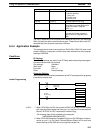
6-1SectionUsing No-protocol Communications
99
Send/Receive Message Frames
Start code
End code
No Yes CR+LF
No
Data
256 bytes max.
256 bytes max.
Data
ED
256 bytes max.
Data
CR+LF
Yes
256 bytes max.
Data
ST
256 bytes max.
Data
ST ED
256 bytes max.
Data
ST CR+LF
• Only the first start code is valid if there is more than one start code.
• Only the first end code is valid if there is more than one end code.
• Use CF+LF if using an end code may cause receptions to be interrupted be-
cause the end code exists in the receive data.
• A transmission delay can be set for PC-initiated communications as a mini-
mum interval between sending commands to the host.
The delay is not used in sending the first command. The delay will affect oth-
er commands only if the time set for the transmission delay has not expired
when the next command is ready to be sent.
If the delay time has already expired when the next command is ready, the
command will be spent immediately. If the delay time has not expired, the
command will be delayed until the time set for the transmission delay has
expired.
The operation of the transmission delay for PC-initiated communications is
illustrated below.
Command sent
Transmission delay
1st TXD(––)
command
2nd TXD(––)
command
Command sent
Transmission delay
Command sent
Transmission delay
3rd TXD(––)
command
4th TXD(––)
command
Command sent
Time
Refer to the CQM1H Programming Manual for details on TXD(––) and RXD(––).


















